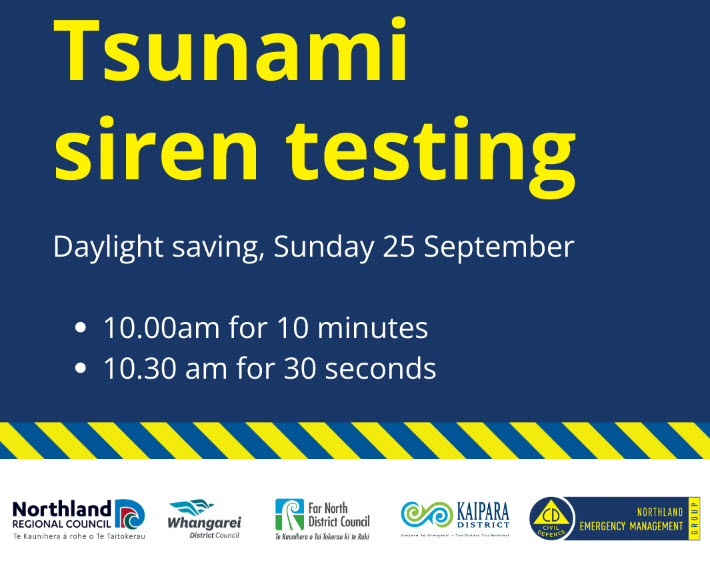Northland tsunami siren testing at beginning of daylight saving
12 Sep 2022, 11:12 AM
Northland’s six-monthly tsunami siren test will take place at the beginning of daylight saving on Sunday 25 September.
The network of more than 200 outdoor tsunami sirens in coastal communities, from Te Hapua in the north to Mangawhai in the south and Ruawai in the west, is checked twice a year, coinciding with the start and finish of daylight saving.
The sirens sound twice: firstly at 10am for 10 minutes and then again at 10.30am for 30 seconds, and will be monitored for any faults.
Indoor sirens will be tested at the same time as the outdoor network. Test alerts will also be sent to users of the Red Cross Hazard app, which can be downloaded for free.
Northland’s outdoor tsunami sirens are funded and owned by the region’s three district councils (Far North, Whangarei and Kaipara) and operated in a partnership which also includes the two electricity networks (Northpower and Top Energy).
The Northland network has been progressively developed since 2007, with a total of 205 sirens installed over that time. However, these will eventually reach the end of their expected life and will need to be either replaced or upgraded.
The region’s four councils agreed through their Long Term Plan (LTP) processes to support the replacement of the current sirens, with the Northland Civil Defence Emergency Management Group coordinating the project.
The new tsunami warning sirens will have greater reach, greater redundancies - such as backup solar power - and voice instruction functionality, allowing specific messages about the tsunami threat and the required actions can be provided in addition to a siren sound.
The $5 million project is expected to take place over the next three to five years - starting early 2023. The existing siren network will be maintained continuously throughout and consultation with coastal communities will be held to support the selection of the siren locations.
Northland Civil Defence Emergency Management Group spokesperson Graeme MacDonald added that people should also be aware of the risk of local source tsunami (those generated on or close to the coast), which could arrive ahead of any official warning. "Everyone who spends time on the coast needs to know the natural warning signs of tsunami - a strong earthquake that is hard to stand up in or one that lasts longer than a minute, or out-of-the ordinary sea behaviour, such as sudden rise or fall and/or unusual noise."
He said Northlanders can check out whether they live, work or play in a tsunami evacuation zone, and plan the quickest route to safety, using the interactive maps at: www.nrc.govt.nz/evacuationzones or if you’re outside of Northland and want to find out the evacuation zones, you can check out the national maps at: getready.govt.nz/emergency/tsunami/tsunami-evacuation-zones/
To hear Northland’s outdoor and indoor tsunami sirens online visit: www.nrc.govt.nz/tsunamisirens

